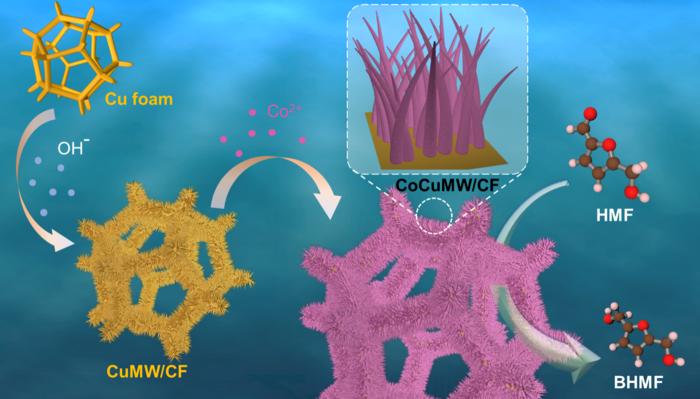
A groundbreaking research effort undertaken by a team from the Ningbo Institute of Materials Technology and Engineering (NIMTE) has unveiled a novel approach to harnessing metal corrosion for the fabrication of high-performance electrodes. This innovative method focuses on the effective upgrading of bio-based 5-hydroxymethylfurfural (HMF), primarily aimed at addressing the challenges associated with biomass conversion processes. The findings of this important research were published in the distinguished journal, Chem Catalysis, reflecting their potential impact on the field of green chemistry and sustainable energy.
Metal corrosion is often perceived negatively due to its association with material degradation and financial loss. However, this research reframes corrosion as a resource rather than a liability, suggesting that the intentional utilization of corrosion processes can lead to advantageous outcomes, particularly in the sphere of biomass upgrading. By strategically inducing corrosion in metal constructs, the researchers have developed a pathway to obtain catalysts that can facilitate the conversion of biomass into value-added products.
Biomass is recognized as one of the planet’s most abundant renewable resources. As the world strives to transition toward sustainable practices, the conversion of biomass into fuels and chemicals has become increasingly relevant. Through catalytic conversion processes, biomass has the potential to substitute traditional fossil resources, thereby playing a crucial role in efforts to achieve peak carbon dioxide emissions and carbon neutrality. This alignment with global sustainability goals underlines the significance of the research conducted by Prof. ZHANG Jian and his team.
The research team adopted a creative approach to integrate corrosion into the catalytic process by combining spontaneous metal degradation with the upgrading of biomass. They successfully synthesized CoCu microwire arrays on copper foam, termed as CoCuMW/CF, through cobalt ion-enhanced corrosion induction. This innovative electrode design taps into the inherent properties of copper, which is known for its high conductivity, while also leveraging the features imparted by the corrosion process.
One of the pivotal breakthroughs achieved with the CoCuMW/CF electrode is its remarkable efficiency in electrochemically reducing HMF to 2,5-bis(hydroxymethyl)furan (BHMF). BHMF is a highly desirable compound with extensive application potential, including its conversion into eco-friendly plastics or rubber products, as well as being a precursor for valuable bio-based chemicals. This step illustrates how the findings not only address the fundamental challenges of biomass conversion but also extend the pipeline towards producing sustainable alternatives to conventional materials.
Performance assessments revealed that the CoCuMW/CF electrode displayed a striking HMF conversion rate of 95.7%, along with an impressive BHMF yield of 85.4% when operated at a potential of -0.5 V relative to the reversible hydrogen electrode (RHE). This level of efficiency showcases the electrode’s superior performance in facilitating HMF hydrogenation within a neutral electrolyte environment. The implications of such high conversion rates could significantly alter the landscape of biomass utilization in chemical production.
Quantitative analysis of the reaction mechanisms revealed that the activation energy associated with the electrocatalytic reduction of HMF was measured at merely 16.6 ± 2.5 kJ·mol-1. This energy requirement is substantially lower than the values reported for traditional thermocatalytic methods. The reduced activation energy underscores the advantages of using electrochemical pathways, paving the way for more efficient processes that require less energy input while achieving higher product yields.
The researchers further employed density functional theory (DFT) calculations to deepen their understanding of the catalytic mechanisms at play. The simulations indicated that the CoCuMW/CF electrode successfully lowered the free energy barriers related to both initial and subsequent hydrogenation steps during the conversion of HMF. This reduction in energy barriers is pivotal as it enhances both the catalytic efficiency and selectivity towards producing BHMF, illustrating the potential of combining theoretical modeling with experimental validation to drive innovation.
The findings challenge existing notions regarding metal corrosion and showcase how this often-detrimental process can be reimagined as a tool for synthesis in electrochemical applications. In realizing highly effective electrochemical hydrogenation processes with copper-based electrocatalysts, the research opens doors to a new era in biomass upgrading that prioritizes both cost-effectiveness and environmental sustainability.
Such advancements are essential for driving the development of economically feasible methods to harness biomass feedstock. The use of copper-based materials, which are abundant and relatively inexpensive, underscores the potential for creating scalable processes that can be implemented globally. The research results provide a roadmap not only for laboratory-scale studies but also for potential industry adoption.
This research initiative was supported by various funding bodies, including the National Natural Science Foundation of China, the Key Research and Development Program of Zhejiang Province, and the Ningbo Science and Technology Bureau. Such collaboration emphasizes the importance of inter-institutional support in fostering groundbreaking scientific endeavors that bridge the gap between academia and practical applications.
In conclusion, the innovative work led by Prof. ZHANG Jian and his team marks a significant advancement in the pursuit of sustainable biomass conversion methods. By revamping the narrative around metal corrosion, they have crafted a new paradigm that potentially transforms a detrimental process into a powerful tool for green chemistry. As the global community continues to grapple with the imperatives of sustainability, such research efforts are pivotal for establishing a cleaner, more sustainable future grounded in the principles of circular economy.
Subject of Research: High-performance electrodes from metal corrosion for biomass upgrading.
Article Title: Utilization of Metal Corrosion to Create Efficient Electrodes for Upgrading Biomass.
News Publication Date: October 2023.
Web References: Chem Catalysis
References: Not applicable.
Image Credits: Image by NIMTE.
Keywords
Electrocatalysis, biomass conversion, corrosion utilization, high-performance electrodes, sustainable chemistry, 5-hydroxymethylfurfural, eco-friendly materials, electrochemical reduction.
Tags: bio-based 5-hydroxymethylfurfuralbiomass upgrading techniquescatalysts for biomass conversionChem Catalysis publicationcorrosion-resistant electrodesgreen chemistry innovationsinnovative electrode fabricationmetal corrosion utilizationrenewable resource utilizationsustainable energy solutionstransitioning to sustainable practicesvalue-added biomass products





